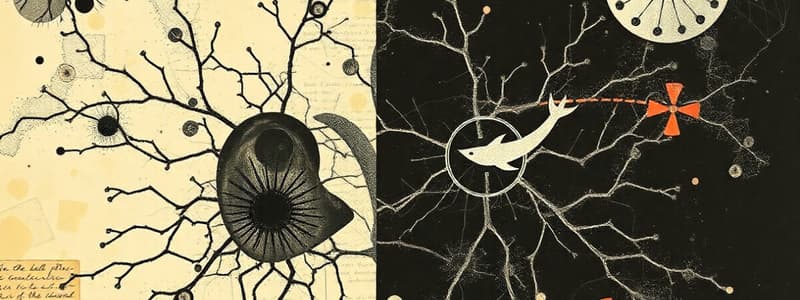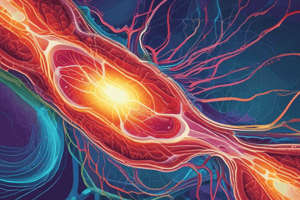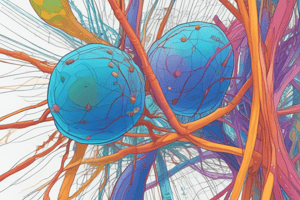Podcast
Questions and Answers
What is the primary function of microtubules in cells?
What is the primary function of microtubules in cells?
- Formation of daughter cells
- Providing structural strength
- Energy transformation during photosynthesis
- Movement of cilia and flagella (correct)
Which of the following correctly describes heterotrophs?
Which of the following correctly describes heterotrophs?
- Organisms that perform chemosynthesis in harsh environments
- Net consumers of CO2 and must consume other organisms (correct)
- Organisms that produce their own food from sunlight
- Organisms that can synthesize complex organic molecules
Which of the following components do plant cells possess that animal cells do not?
Which of the following components do plant cells possess that animal cells do not?
- Cell wall (correct)
- Nucleus
- Ribosomes
- Mitochondria
What substances are produced during photosynthesis?
What substances are produced during photosynthesis?
What is the role of chloroplasts in plant cells?
What is the role of chloroplasts in plant cells?
Which process allows some autotrophs to derive organic material from chemicals?
Which process allows some autotrophs to derive organic material from chemicals?
What is the primary characteristic of diffusion?
What is the primary characteristic of diffusion?
In cell biology, what is the primary function of intermediate filaments?
In cell biology, what is the primary function of intermediate filaments?
Which of the following statements about energy transformation is true?
Which of the following statements about energy transformation is true?
Which of the following statements regarding osmosis is true?
Which of the following statements regarding osmosis is true?
What happens to an animal cell placed in a hypotonic solution?
What happens to an animal cell placed in a hypotonic solution?
What is the function of channel proteins in facilitated diffusion?
What is the function of channel proteins in facilitated diffusion?
Which term describes the ability of an extracellular solution to influence water movement in a cell?
Which term describes the ability of an extracellular solution to influence water movement in a cell?
What is required for active transport mechanisms?
What is required for active transport mechanisms?
In which situation will an animal cell be in an isotonic solution?
In which situation will an animal cell be in an isotonic solution?
What specific molecule is transported by the sodium-potassium pump?
What specific molecule is transported by the sodium-potassium pump?
What are homologous chromosomes?
What are homologous chromosomes?
What is the main purpose of meiosis?
What is the main purpose of meiosis?
What occurs during Prophase I of meiosis?
What occurs during Prophase I of meiosis?
Which statement is true regarding somatic cells?
Which statement is true regarding somatic cells?
What is a key difference between sexual and asexual reproduction?
What is a key difference between sexual and asexual reproduction?
What is the result of meiosis?
What is the result of meiosis?
During which stage of meiosis does the reduction in chromosome number occur?
During which stage of meiosis does the reduction in chromosome number occur?
What process allows genetic information exchange between homologous chromosomes?
What process allows genetic information exchange between homologous chromosomes?
What is the primary function of exocytosis in cells?
What is the primary function of exocytosis in cells?
Which process allows nerve cells to exchange sodium and potassium ions?
Which process allows nerve cells to exchange sodium and potassium ions?
What type of molecule is typically transported into cells via phagocytosis?
What type of molecule is typically transported into cells via phagocytosis?
Why do smaller cells have a higher surface area to volume ratio?
Why do smaller cells have a higher surface area to volume ratio?
Which type of transport requires channel proteins due to the charge of the molecule?
Which type of transport requires channel proteins due to the charge of the molecule?
What is the role of enzymes in metabolic pathways?
What is the role of enzymes in metabolic pathways?
Which type of endocytosis is specifically used for the uptake of liquids?
Which type of endocytosis is specifically used for the uptake of liquids?
What structure within mitochondria contains enzymes necessary for ATP synthesis?
What structure within mitochondria contains enzymes necessary for ATP synthesis?
What is the primary outcome of fertilisation in terms of genetic variation?
What is the primary outcome of fertilisation in terms of genetic variation?
What process occurs during prophase 1 to increase genetic variation?
What process occurs during prophase 1 to increase genetic variation?
Which statement best describes independent assortment?
Which statement best describes independent assortment?
How do mutations contribute to variation in sexually reproducing organisms?
How do mutations contribute to variation in sexually reproducing organisms?
During which stage of meiosis do homologous chromosomes exchange genetic material?
During which stage of meiosis do homologous chromosomes exchange genetic material?
What best characterizes daughter cells produced by meiosis compared to those produced by mitosis?
What best characterizes daughter cells produced by meiosis compared to those produced by mitosis?
Which factor does NOT contribute to genetic variation in sexually reproducing organisms?
Which factor does NOT contribute to genetic variation in sexually reproducing organisms?
What role do enzymes play during crossing over?
What role do enzymes play during crossing over?
Flashcards are hidden until you start studying
Study Notes
Microfilaments
- Made of actin protein
- Are assembled into long filaments
- Used in movement, such as the formation of daughter cells during cytokinesis
Microtubules
- Made of tubulin protein
- Are assembled into long filaments
- Involved in the movement of cilia and flagella
- Also help to hold organelles in place within cells
Intermediate filaments
- Made of multiple proteins
- Provide strength and structural support to cells
Animal vs Plant Cells
- Animal cells lack a cell wall and chloroplasts
- Plant cells have a larger vacuole and a cell wall
- Plants can undergo photosynthesis, making them autotrophs. Animals lack this ability and are heterotrophs
- Plants have a more rigid shape due to their cell walls
Uses for Energy
- Energy is needed for essential cellular processes, such as:
- Synthesis of molecules
- Movement
- Cell division
- Active transport
- Energy cannot be created nor destroyed, only transformed from one form to another
Autotrophs
- Produce their own food through the conversion of external energy sources into usable energy
- Are producers in ecosystems
- Examples include plants
- Can synthesize complex organic molecules, like glucose, from external energy sources, such as sunlight
- Take in carbon dioxide and water, releasing oxygen and glucose
- Are net consumers of carbon dioxide
Heterotrophs
- Obtain energy by consuming other organisms
- Are net producers of carbon dioxide
- Cannot synthesize their own complex organic molecules, relying on autotrophs for nutrition
- Gain energy through eating other organisms, ultimately depending on autotrophs for all nutrients
Chemosynthesis
- Some autotrophs use external energy sources from chemicals to produce organic material
- Commonly occurs in environments without sunlight, such as hydrothermal vents
Photosynthesis
- Occurs in plants, specifically within chloroplasts
- Converts carbon dioxide and water into oxygen and glucose using sunlight as the energy source
- Cells involved in photosynthesis contain numerous chloroplasts, giving them a green color due to chlorophyll
- Specialised leaf structures maximise the rate of photosynthesis
- Chloroplasts can move within cells to reach optimal light conditions
Diffusion
- Passive process, requiring no energy
- Movement of molecules across the cell membrane, between phospholipid molecules
- Travels with the concentration gradient, from high to low concentration
- Aims to reach equilibrium between the intra and extra cellular fluids
- Example: Gas exchange in the lungs
Facilitated Diffusion
- Passive process, requiring no energy
- Works with the concentration gradient to reach equilibrium
- Utilises channel proteins to facilitate the movement of larger molecules across the membrane
- Example: Transport of glucose
Osmosis
- Passive transport that specifically moves water across the membrane
- Travels through aquaporins, proteins specifically designed for water transport
- Direction of travel is determined by the solute concentration
- Aims to reach equilibrium
- Hypotonic: Less concentrated solution, causing water to move into the cell
- Isotonic: Equal concentration, no net movement of water
- Hypertonic: More concentrated solution, causing water to move out of the cell
- Tonicity: The ability of an extracellular solution to make water move into or out of a cell via osmosis
- Osmolarity: The concentration of a solution expressed as the total number of solute particles per liter
Active Transport
- Requires energy to move molecules across the membrane
- Utilizes protein pumps
- Movement usually occurs against the concentration gradient
- Transport proteins are located in the cell membrane
- Specialized for specific molecules
- Requires ATP to operate
- Example: Sodium potassium pump, which occurs in nerve cells to maintain electrochemical gradients
Exocytosis
- A type of cytosis used to move large substances across the membrane by forming vesicles
- Exo = exit, meaning substances are released from the cell
- Often used for the removal of waste products
- Vesicles containing substances from the Golgi apparatus fuse with the membrane to release their contents
Endocytosis
- The opposite of exocytosis, bringing substances into the cell
- The cell membrane engulfs particles, forming a vesicle that brings the substance into the cell
- Two types:
- Pinocytosis: For liquids
- Phagocytosis: For solids/food, used by white blood cells to engulf pathogens
SA/V Ratio
- Represents the ratio between the surface area of a cell and its volume
- Smaller cells have a higher SA:V ratio, making them more efficient
- Part of the reason cells divide is to maintain an efficient SA:V ratio
Examples of Molecule Transport across the Membrane
- Small hydrophobic molecules: (e.g. CO2 and O2) can passively diffuse across the membrane without needing additional energy or special proteins
- Small hydrophilic molecules: (e.g. water) passively diffuse but require aquaporins for transport
- Ions: Possessing a charge, require channel proteins for facilitated diffusion
- Large hydrophilic molecules: (e.g. glucose and amino acids) cannot passively cross but need channel proteins or active transport depending on the concentration gradient
Cell Metabolism
- Refers to the biochemical processes that occur within a cell
- Essential for cell survival
- Highly influenced by enzymes
- Metabolic pathways exist, with specific steps facilitated by enzymes
- Many processes occur within membrane-bound structures
- Membranes often contain enzymes that facilitate the metabolic pathway
Internal membrane of mitochondria
- Inner membrane is highly folded to form cristae
- The membrane contains enzymes that assist in ATP synthesis, including ATP synthase
Chromosome
- Condensed strands of DNA and proteins that carry genetic information
Cytokinesis
- The last stage of the cell cycle where the cytoplasm splits
Cytoplasm
- The entire internal environment of a cell, including the cytosol and organelles
Cytosol
- The liquid component of the cytoplasm
Cristae
- Folded inner membrane of a mitochondria
Somatic vs Germline/Gametes
- Somatic cells are all body cells, containing a diploid number of chromosomes
- Germline cells are sex cells/gametes (egg and sperm), containing a haploid number of chromosomes
Homologous Chromosomes
- Chromosomes of the same type, carrying the same genes but potentially different alleles (e.g., chromosome 1 from the mother and father)
Sexual Reproduction vs Asexual Reproduction
- Sexual reproduction involves the combination of two different cells (usually from different parents) to form a new organism
- Asexual reproduction does not require the fusion of two cells
- Sexual reproduction requires fertilization
- Some plants can self-fertilize, involving one parent organism but still requiring the fusion of two cells
Meiosis
- Cell division that forms haploid cells with half the number of chromosomes
- Results in four genetically non-identical daughter cells
- In animals, occurs in the gonads
- Two stages:
- Meiosis I: Reduction stage, halves the number of chromosomes
- Meiosis II: Similar to mitosis, separates chromatids
Meiosis I: Reduction Stage
- Prophase I:
- Chromosomes condense and become visible
- Sister chromatids pair up
- Homologous chromosomes also pair, a process called synapsis, forming structures called bivalents (four chromatids together)
- Nuclear membrane dissolves
- Spindle fibres start to form
- Genetic information is exchanged between homologous pairs through crossing over
Variation
- Due to differences between meiosis and mitosis, the daughter cells produced from meiosis are not genetically identical
- This genetic variation is essential for evolution, allowing populations to adapt to changing environments
Crossing Over
- Occurs during prophase I when bivalents form
- Genetic material is swapped between homologous chromosome pairs
- The point of swapping is called a chiasmata
- Regions of DNA from different chromosomes are cut and exchanged, creating recombinant DNA
- This process is completely random, occurring 2-3 times per chromosome
Independent Assortment
- Occurs during metaphase I
- Homologous pairs align at the metaphase plate (center of the cell)
- The orientation of each pair is random, determining which pole the maternal and paternal chromosomes will face
- Increases variation in daughter cells as the homologous pairs are pulled apart during anaphase.
Fertilization
- Random process where the sperm and egg fuse
- Increases genetic variability, as it is impossible to predict which specific sperm and egg will combine
Mutations
- Can occur in both sexually and asexually reproducing organisms
- Rare but introduce new variations into the genome
- The only source of variation in asexually reproducing organisms
Cell Division
- Process by which cells split and duplicate
- Occurs through mitosis, binary fission, or meiosis
- Essential for growth, repair, and reproduction.
Studying That Suits You
Use AI to generate personalized quizzes and flashcards to suit your learning preferences.




